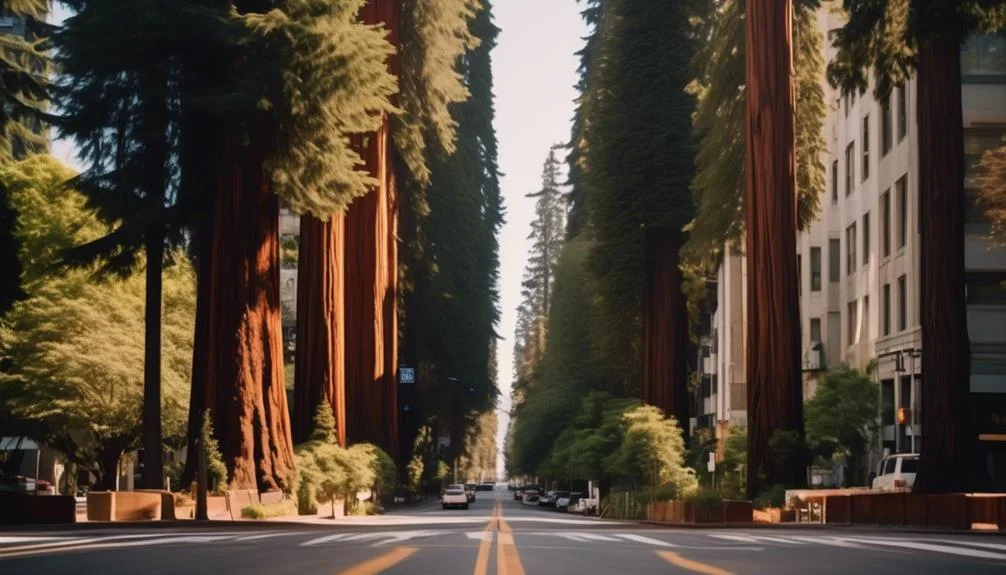Is it a good idea to plant redwood trees along city streets? These towering giants are known for their impressive height and beauty, but can they thrive in urban areas?
Let's explore the unique qualities and potential advantages of incorporating redwood trees into urban landscapes. From their positive impact on the environment to the sense of calm they can bring to bustling city streets, the idea of planting redwoods might just surprise you.
Redwood Trees Characteristics
Redwood trees are renowned for their towering height and impressive longevity, making them a striking addition to any landscape. These giants can reach heights of over 300 feet, making them the tallest trees on the planet. They're also known for their rapid growth, with some species growing up to 2-3 feet per year under the right conditions.
When it comes to maintenance, redwood trees require minimal care once established. Regular watering, especially during dry spells, is essential for their growth. Pruning should be minimal, focusing on removing dead or damaged branches to maintain their natural shape.
With their remarkable growth rate and low maintenance needs, redwood trees are an excellent choice for adding grandeur to any street or landscape.
Considerations for Street Planting
When choosing redwood trees for street planting, it's crucial to consider various factors to ensure their successful growth and integration into the urban environment. Proper tree selection and maintenance are essential for their long-term health and sustainability in an urban setting. Additionally, the soil quality plays a significant role in the successful growth of redwood trees. Here are some important considerations for street planting:
| Consideration | Description |
|---|---|
| Tree Selection | Choose redwood tree species that are well-suited for urban environments and can thrive in limited soil spaces. |
| Maintenance | Regular pruning and watering are crucial to ensure the health and longevity of redwood trees in an urban setting. |
| Urban Environment | Consider the surrounding infrastructure, such as sidewalks and buildings, to ensure the trees won't cause obstructions or damage. |
| Soil Quality | Assess the soil quality to ensure it meets the specific requirements of redwood trees for proper growth and development. |
| Sustainability | Plan for long-term sustainability by considering the environmental impact and the ability of the trees to withstand urban conditions. |
Considering these factors will help ensure the successful integration of redwood trees into street planting projects.
Benefits of Redwood Trees in Urban Areas
In urban areas, redwood trees offer numerous benefits. Their impressive size and shade provide relief from the hot sun and create a more comfortable environment. Redwood trees also play a crucial role in urban greening by mitigating the environmental impact of densely populated areas. Their towering presence and expansive tree canopy reduce the urban heat island effect, helping to create a cooler city. Furthermore, the dense foliage of redwood trees acts as a natural air filter. By trapping pollutants and particulate matter, they help improve air quality in the urban environment. This not only enhances the visual appeal of the cityscape but also contributes to a healthier and more sustainable urban environment.
Potential Challenges of Street Planting With Redwood Trees
Considering the many benefits redwood trees offer in urban settings, it's important to address the potential challenges associated with planting them along city streets.
Root damage is a significant concern when planting redwood trees in urban areas. Their roots are vigorous and can potentially disrupt sidewalks, roadways, and underground utilities. This could lead to costly repairs and pose safety hazards.
Additionally, the maintenance requirements for redwood trees in urban settings can be demanding. Regular pruning may be necessary to prevent overhanging branches from obstructing walkways and roads. Moreover, redwood trees often require consistent watering and care, which can be challenging to maintain in busy urban environments.
It's crucial for city planners and arborists to carefully consider these challenges before deciding to plant redwood trees along city streets.
Best Practices for Successful Street Planting
To ensure successful street planting of redwood trees, careful consideration of soil conditions and adequate space for root growth is essential. When choosing a tree species for urban landscaping, opt for redwood varieties with non-invasive root systems.
Follow these best practices for successful street planting:
- Soil Assessment
- Conduct a thorough assessment of the soil quality to ensure it's well-draining and nutrient-rich.
- Amend the soil as needed to provide an optimal growing environment for redwood trees.
Conclusion
To maximize the benefits of redwood trees in urban areas, thoughtful planning and collaboration with experts are essential. Overcoming space constraints and root system challenges can ensure their successful integration, enhancing the appeal and sustainability of city streets.
How can we effectively harness the potential of redwood trees to create vibrant and inviting urban landscapes?
Mark Hoffman is a dedicated arborist and tree care specialist with over a decade of experience. His love for trees began when he visited Yosemite National Park as a teenager and was awestruck by the giant sequoias. Mark pursued his passion by studying forestry at Michigan Technological University, where he earned a Bachelor of Science degree.
Since then, he has worked tirelessly in the field of arboriculture, helping to preserve and protect trees in his community. His expertise and dedication have made him a respected leader in the industry and a valuable resource for anyone seeking advice on tree care.
